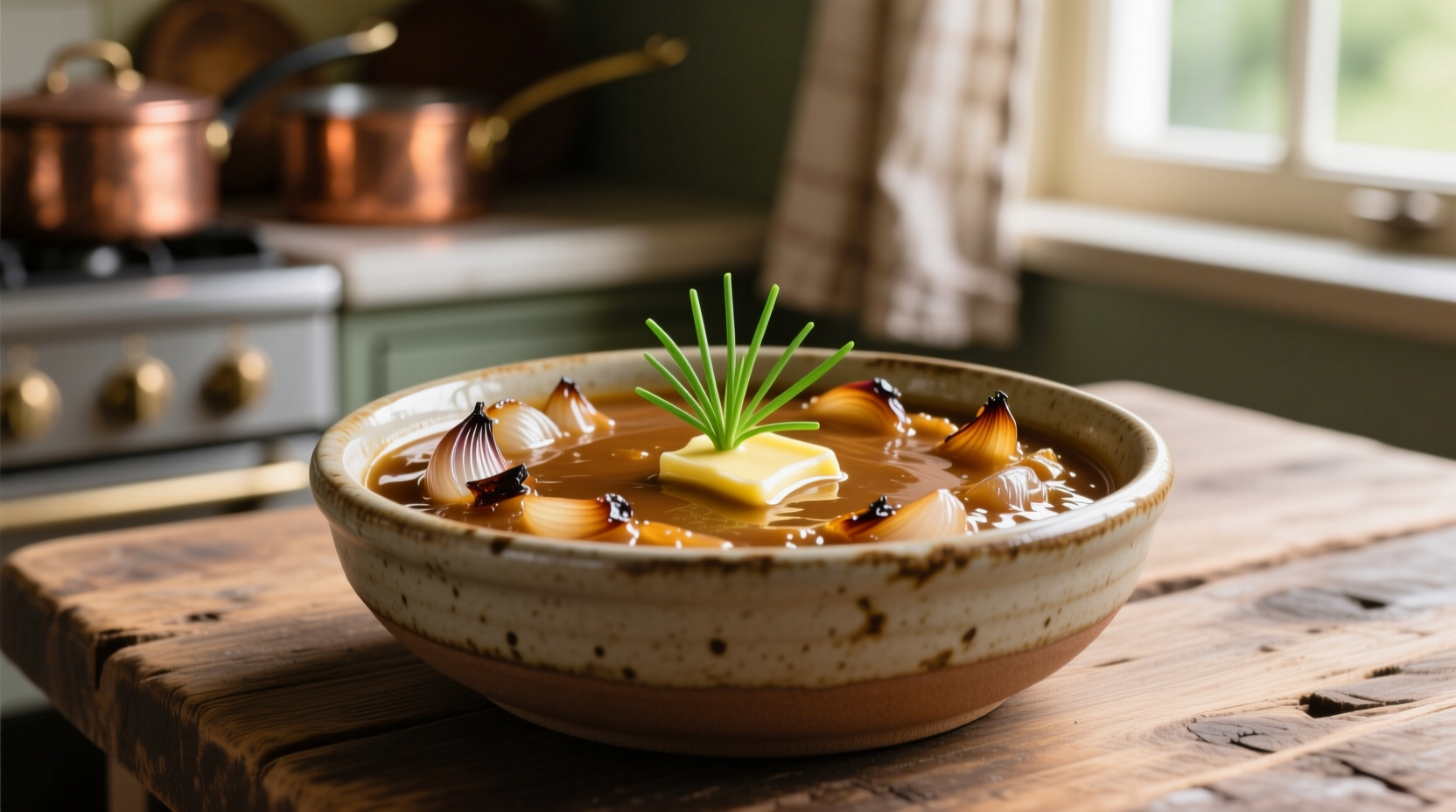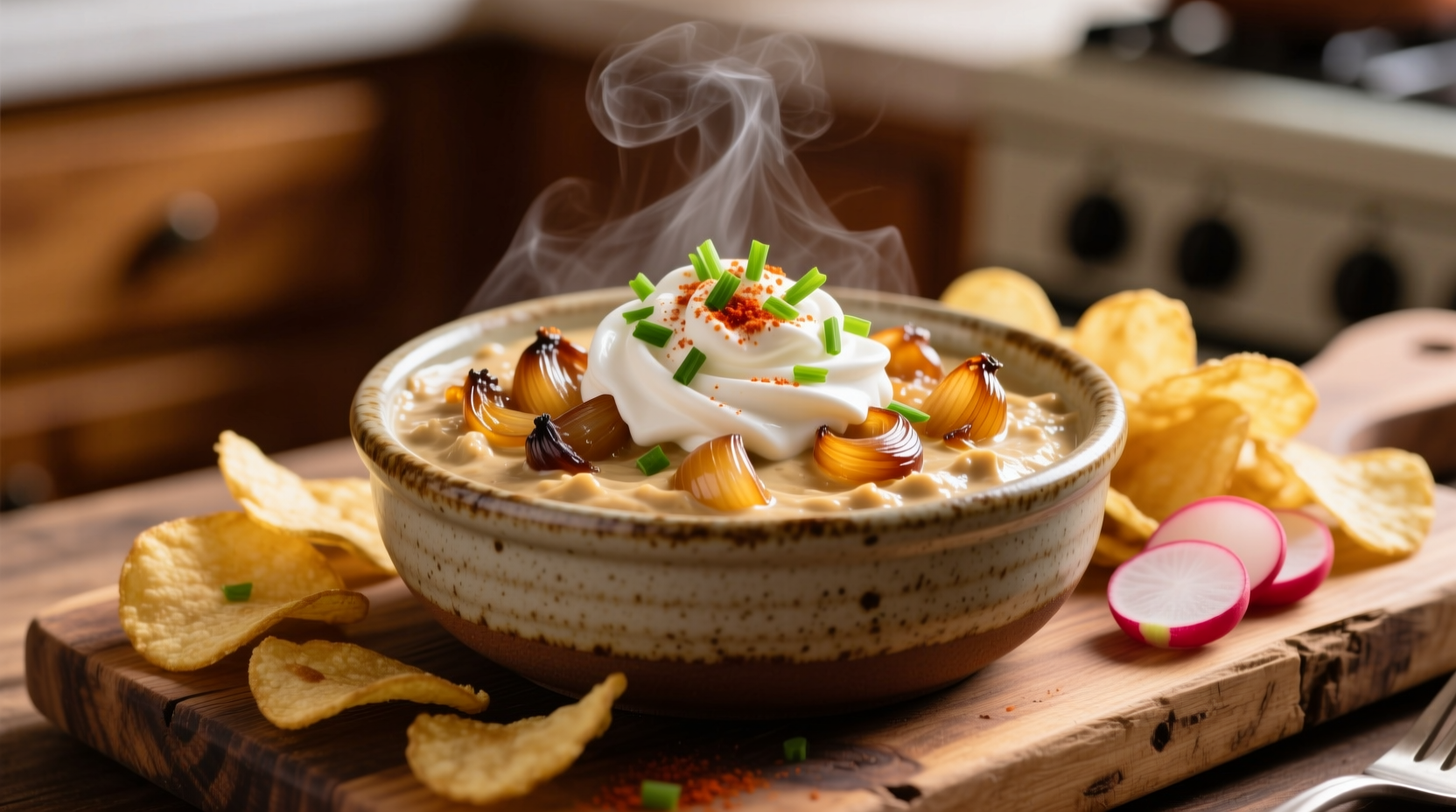The best warm onion dip combines caramelized onions, quality dairy, and the perfect balance of seasonings. This foolproof recipe delivers a rich, creamy dip with deep onion flavor that's perfect for parties, game days, or cozy nights in. You'll need just 7 simple ingredients and 45 minutes to create a crowd-pleasing dip that outshines store-bought versions every time.
There's nothing quite like the aroma of onions slowly caramelizing as they transform from sharp and pungent to sweet and complex. Warm onion dip represents one of those magical culinary transformations where humble ingredients become something extraordinary. Whether you're hosting a gathering or simply craving comfort food, mastering this classic appetizer elevates your cooking repertoire with minimal effort.
Why This Warm Onion Dip Recipe Works
Professional chefs understand that the secret to exceptional onion dip lies in the caramelization process. Unlike quick sautéed versions, properly caramelized onions develop over 400 flavor compounds through the Maillard reaction, creating that signature sweet-savory depth. According to food science research from the Culinary Institute of America, cooking onions slowly over medium-low heat for 25-30 minutes maximizes flavor development while preventing burning.
| Onion Variety | Flavor Profile | Best For |
|---|---|---|
| Yellow Onions | Sweet when cooked, robust flavor | Classic dip foundation |
| Shallots | Delicate, subtle sweetness | Elegant gatherings |
| Red Onions | Bright, slightly tart | Adding visual contrast |
| Green Onions | Fresh, mild onion flavor | Garnish and subtle flavor |
The Essential Ingredients Breakdown
Quality ingredients make the difference between ordinary and exceptional dip. While some recipes call for onion soup mix, the best homemade versions rely on fresh components:
- Onions: 3 large yellow onions (about 1½ pounds), thinly sliced
- Fat: 3 tablespoons unsalted butter or olive oil (butter adds richness)
- Dairy Base: 8 ounces cream cheese (full-fat for best texture)
- Liquid: ½ cup sour cream or Greek yogurt
- Seasonings: 1 teaspoon Worcestershire sauce, ½ teaspoon garlic powder, salt and freshly ground black pepper to taste
- Optional Enhancements: Fresh thyme, smoked paprika, or a splash of white wine

Step-by-Step Preparation Guide
Follow these professional techniques to achieve perfect results every time:
Caramelizing the Onions Properly
This critical step requires patience but delivers unmatched flavor. The USDA Food Safety and Inspection Service recommends cooking onions to an internal temperature of 165°F (74°C) to ensure safety while developing optimal flavor.
- Heat butter in a heavy-bottomed skillet over medium-low heat
- Add sliced onions and stir to coat with fat
- Cook slowly, stirring every 5 minutes, for 25-30 minutes until deep golden brown
- Optional: Add 1 tablespoon brown sugar during the last 10 minutes for enhanced caramelization
- Stir in Worcestershire sauce and cook for 1 additional minute
- Remove from heat and let cool slightly
Creating the Perfect Dip Texture
Texture makes or breaks a dip. Professional kitchens maintain that cream cheese should be at room temperature before mixing to prevent lumps. Combine ingredients in this order:
- Beat softened cream cheese until smooth
- Gradually incorporate caramelized onions and any pan juices
- Fold in sour cream until just combined
- Add seasonings and mix gently
- Chill for at least 30 minutes before serving to allow flavors to meld
Serving Temperature and Presentation Tips
Warm onion dip should be served at precisely 140°F (60°C) - hot enough to maintain its creamy texture but not so hot that it separates. Food safety experts from the FDA recommend keeping hot foods above 140°F to prevent bacterial growth during serving.
For elegant presentation:
- Transfer to a small cast-iron skillet for serving
- Garnish with fresh chives or parsley
- Surround with an attractive arrangement of dippers
- Place the serving dish on a trivet to maintain warmth
Ideal Pairings and Dippers
The right accompaniments elevate your dip from good to unforgettable. Consider these professional pairing suggestions:
- Crispy Options: Baguette slices, pita chips, kettle-cooked potato chips
- Fresh Options: Bell pepper strips, cucumber rounds, endive leaves
- Unexpected Options: Roasted cauliflower florets, apple slices, pretzel rods
Storage and Reheating Guidelines
Proper storage maintains both safety and quality. The National Center for Home Food Preservation recommends:
- Refrigerate leftovers within 2 hours of preparation
- Store in an airtight container for up to 4 days
- Freeze for up to 2 months (thaw in refrigerator before reheating)
- Reheat gently in the microwave at 50% power or in a low oven (250°F/120°C)
Troubleshooting Common Issues
Even experienced cooks encounter challenges with onion dip. Here's how to solve them:
- Too watery: Drain excess liquid from caramelized onions before mixing
- Too thick: Gradually add warm milk or cream until desired consistency
- Bland flavor: Add a pinch of salt and acid (lemon juice or vinegar) to brighten
- Separated dip: Gently reheat while whisking in a small amount of warm cream
Historical Evolution of Onion Dip
Onion dip has an interesting culinary journey. While onion-based sauces date back to ancient Rome, the modern American version emerged in the 1950s with the rise of convenience foods. The iconic Lipton onion soup mix version became popular in the 1960s, but contemporary chefs have returned to scratch-made versions that highlight the natural sweetness of properly caramelized onions. Food historians note that the French have enjoyed similar onion-based dips since the 18th century, often served with crusty bread.
Customization Ideas for Different Occasions
Adapt this versatile recipe for any gathering:
- Sports Gatherings: Add diced jalapeños and smoked paprika for a kick
- Elegant Events: Use shallots instead of yellow onions and garnish with chive blossoms
- Health-Conscious: Substitute Greek yogurt for sour cream and reduce fat content
- Seasonal Twists: Add roasted garlic in winter or fresh herbs in summer
Why Homemade Beats Store-Bought Every Time
Commercial onion dips often contain preservatives, artificial flavors, and excessive sodium. A study published in the Journal of Sensory Studies found that participants consistently preferred homemade versions for their brighter flavor and cleaner ingredient profile. When you make your own, you control the quality of ingredients and can adjust flavors to your exact preference.











 浙公网安备
33010002000092号
浙公网安备
33010002000092号 浙B2-20120091-4
浙B2-20120091-4